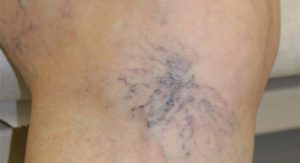 Q. What are Spider Veins?
Q. What are Spider Veins?
A. Spider veins are fine thread-like veins found on the skin surface, which are commonly seen anywhere in the legs. Large purple clusters of spider veins are referred to as telangiectasia. Spider veins & telangiectasia may be a sign of underlying vein disease, especially when found below the knee and around the ankle. Treatment of straight forward cosmetic spider veins is best accomplished with a painless procedure called sclerotherapy, where a special medication is injected directly into the spider veins through a tiny needle. The medication causes inflammation of the lining of the veins and subsequently closure of the veins and disappearance, which may take weeks to months to occur.
Q. What causes spider veins in the legs?
A. Spider veins can occur anywhere on the legs and may be related to the valves inside the veins not working properly. Spider veins on the face are often the result of excessive sun exposure or alcohol consumption. Direct trauma to an area of the leg or thigh might also result in spider veins.
Q. Can spider veins cause pain in the legs?
A. Although spider veins are rarely painful, they may be uncomfortable or ache when associated with underlying venous disease. In cases where there is associated discomfort or pain, a thorough venous evaluation should be considered.
Q. How do you treat spider veins?
A. Although there are a variety of homeopathic remedies proposed such as Horse Chestnut extract, Witch Hazel and others, the medically proven and most commonly acceptable treatment for spider veins is a procedure called sclerotherapy, either with injection of liquid medication (polidocanol, sotradecol or hypertonic saline) or use of a LASER.
Q What causes varicose veins?
A. A problem in the valves in your veins can prevent blood from flowing normally and cause varicose veins or spider veins. Your heart pumps blood filled with oxygen and nutrients through your arteries to your whole body. The venous blood in the legs must return against the force of gravity. When the check valves fail to close tightly, pressure builds up in the veins resulting in spider veins, varicose veins and other more advanced signs of venous disease.
Q. What happens if varicose veins are left untreated?
A. If left uninvestigated and untreated, venous insufficiency, may eventually result in excess blood leaking into the tissues of the leg. The patient may experience painful swelling and inflammation as well as pigmentation and thickening of the skin of the lower legs, which is known as stasis pigmentation or stasis dermatitis.
Q. Can spider veins turn into varicose veins?
A. Spider veins are the mildest physical sign of venous insufficiency. Next on the continuum of vein disease is a telangiectasia, which is a cluster of spider veins. Varicose veins are the next most advanced physical sign on the spectrum of vein disease signs. Although, spider veins do not necessarily “turn into” varicose veins, if vein disease is not diagnosed and left alone without appropriate treatment, the signs of venous disease usually progress over time.
Q. Is exercise beneficial for varicose veins?
A. Exercise, including running, is usually a good thing for your veins. “Exercise is always good for the circulation,” suggests Dr. Magnant. “Walking, elliptical machines, pool exercises or running leads to more calf-muscle pump activity and more blood returning to the heart and less pooling of blood in the calves.
Q. Will compression stockings help spider & varicose veins?
A. Compression hose or stockings are the first line of conservative therapy in the management of vein disease. They will not prevent the development of spider veins or varicose veins but they will help with the symptoms of vein disease and slow down the progression of the disease. They function as a supportive mechanism applying external pressure to counteract the pressure from the leaky veins within the leg. Compression hose should be worn during the waking hours of the days when one is up on their feet sitting or standing, and taken off prior to bed time.
Q. What type of doctor should I see for my spider veins?
A. Your best choice is an experienced Board
Certified Vascular Surgeon or a physician with board certification by the American Vein and Lymphatic Society whose practice is dedicated and focused on the modern evaluation and management of venous disease. Inquire regarding their experience, number of years in practice, number of procedures performed and which procedures they offer for vein therapy. The final check should be through a reliable online review site such as Healthgrades.com or Vitals.com and your primary care physician.
Q. Are spider veins hereditary?
A. Yes, venous disease is inherited, included in which are spider veins. Approximately 50% of females and 33% of males will develop spider veins during their lifetime.
Q: I have had spider vein treatment in the past with sclerotherapy, but the treatment did not seem to work and the veins came back?
A. While there are no guarantees that spider vein injections will work long term, injection sclerotherapy by an expert with Asclera (polidocanol) usually yields excellent results. If you have been frustrated by the incomplete response of your spider vein therapy, it may be best to consider a thorough vein investigation including diagnostic ultrasonography to rule-out a deeper vein problem. There might be an underlying issue such as leaky valves which requires correction with a
minimally invasive sealing procedure (endovenous ablation) or ultrasound guided foam sclerotherapy with Asclera or Varithena.
Vein Specialists
Dr. Joseph G. Magnant
239-694-VEIN(8346)
WeKnowVeins.com
1500 Royal Palm Square Blvd., Suite 105, Fort Myers, Florida | 3359 Woods Edge Circle, Suite 102, Bonita Springs, Florida









